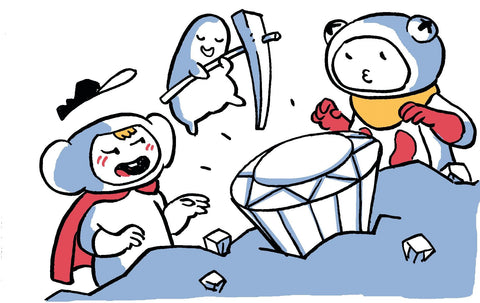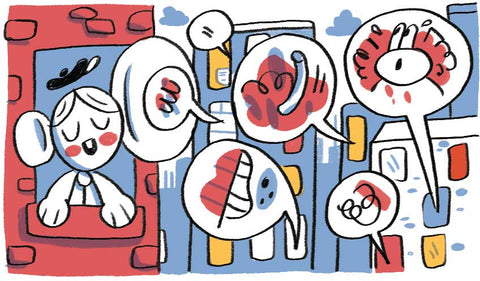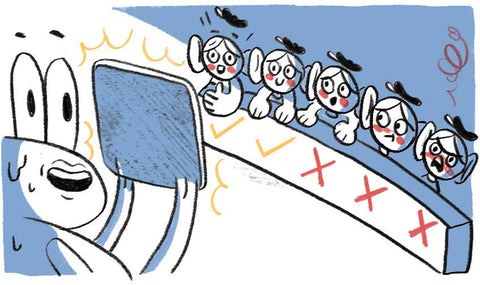ℹ️ Skip to key parts of the session by clicking on the chapter dots along the timeline.
User Story Mapping is one of many ways to map a journey, demonstrated by Tom Kerwin - author of upcoming Pip Deck, Innovation Tactics.
People pick up a backlog ticket and don’t know how it fits into the bigger picture. What we work on becomes disjointed. And we end up building too much, than we needed to get going. Not found a good way to put constraints on what we build.
It was always a bit awkward, especially with developers, to explain or get people bought into the concept. What’s the right size of story or ticket? What level of granularity.
Task level user stories are a little bit like stones. When is a stone a boulder, when is a boulder a rock? There is no clear difference.
Red ticket: who is the user
Green: “flying above the sea”: a grouping of steps, the broad strokes of what is happening
Yellow: “at sea level”. step-by-step story of what they’re doing.
Pink: Questions
Doing your first User Story Map with the Morning Routine is night and day versus introducing it without this onboarding.
It’s like magic. Taking something people intuitively understand. Some differences matter, some differences don’t. Going through the process creates familiarity with the tool, which then helps you use the tool to explore something unfamiliar.
- Familiarity + familiarity = comfort
- Familiarity + unfamiliarity = just enough confidence to explore
- Unfamiliarity + unfamiliar = anxiety
The Morning Routine: A neat way to introduce User Story Mapping to your team
Step 1. Write the individual steps of your morning routine
How much do you break down each step?
It depends what the user cares about, and what your team is going to focus on. There is no right answer. Further detail can be added underneath the step “deeper underwater”.
Without the morning routine, it’s hard to grasp if you go high-level detail or low-level detail.
You’ll end up with verb/noun pairs. do + thing, e.g. check + phone. This is a task level story that sits on sea level. The result should be a straight forward story.
Step 2. Collaboratively work together to combine stories into a master story
Fit everyone's routine in to see the differences. Exploring which sequences matter, and which don’t. Any order doesn’t matter. Some sequences don’t matter.
Don’t have different steps. Aim for an amalgamated version. Agree on wording.
Find the differences where you agree and disagree, this is a hugely valuable part of this process. The conversations. Stack details of a step underneath (further below the sea, as detail gets more granular)
People identify a gap, then have the conversation “where should this go?”. Consider the sequence. Does it matter? Would you wash your hands before you shower?
What happens when there are steps that are only applicable to certain users? Or outliers?
There isn’t a right way of doing it! As long as you’re telling a story that is coherent from start til end.
You can bundle anomalies. Pets + babies could be labeled as dependents. Or you could go down in detail to introduce alternatives. Feel your way through as you go. It can help to frame your user story map around the goal.
Who’s story is this? What sort of person are we laying out the morning routine for?
Step 3: What things would you want to naturally do together, without breaking them up arbitrarily? Bundle them up at the Activity level step.
The discussion of where something goes is more important than writing it down.
Cycling round between getting thoughts, and telling the story.
“Hang on a minute, that doesn’t make sense”
Reshape it, something forms, iterative.
How do you deal with conflicts?
“Does it really matter?”
“Could they realistically do it in different orders if they so desire?”
“Does the business want it, or does the user?”
A digital user story map is easier to share and probe.
Step 4: Test the story to see if it makes sense
Read out the story
You’ll discover questions, which you can raise with pink post its.
Step 5: What if we make this the perfect morning? What would we change?
Should this be a map of the future or now?
We’re more interested in what the user’s life is like now. So we can see where our future vision might fit in.
You can do either, but be clear which you’re working on.
You can find archetypal users through telling individual stories of your uses, common bundles will appear.
How do you show personas? Multiple red sticky notes or one map per user?
Can you have multiple users on one map?
Thinking of the possibility of adapting it to have a scaffolding that’s similar for everyone, but then multiple swim lanes and show where things are different, and how the stories diverge - a choose your own adventure idea.
Step 6: Zoom in, zoom out. See the big picture of what our customer is trying to do. And we can zoom in and see the details and add more if we want to.
How do we know which stuff is the most important stuff?
Setting a target persona and the choice of where we’re fitting into their life
Step 7: The Drama Exercise
You’ve got an early meeting this morning, your alarm clock failed and you’ve only got 10 minutes to get out of the house. What parts of the morning routine are you going to drop, or adapt?
User Story Maps - it’s hard to preempt the questions you want to find the answer to, until you make a map. You may never have thought about it. The first principle that workshops and tools allow us to have conversations we might not otherwise have had.
Within the 10 mins, our aim is still to realise the value of getting out of the house. In the process of stripping it back, we’ve made a lighter-weight version, but we still have an end-to-end process. This could then become our first sprint. To make this skeleton so our product can ’stand up’ from day one.
You might realise your steps can be outsourced.
We tend to get bogged down on the edge-cases.
One thing to notice: We don’t invest equally in each step.
We kept all of certain steps. But we’ve reduced others. We can get by.
Another that’s interesting. It’s much easier to go into depth when each step is available. We can understand what we need to leave in, and take out.
Creating a sense of urgency with a story is really engaging.
Prioritising by relating to something you experience makes it really easy to prioritise.
It becomes a living backlog.
What happens next?
What if you had an extra 5 minutes or 10 minutes, what more could you do?
Use a User Story Map as a form of research. Find out what you need to do, before you start. Find the solution by finding the problem.
It’s possible to write up the User Story Map as a coherent, long-form story. The dialog can help bring it alive.
Aside: Conversational prototyping
Important takeaway: The value is the conversations you have. “Oh I’m glad we asked that questions now rather than later!” Makes it all worth it. Better to find out now than when it’s too late.
“Is this a coherent story that holds together?”
It becomes a powerful tool for conversation and communication.
A User Story is like a Rosetta Stone for a business. The granularity has to be different for different people. Dev needs detail. CEO needs high level. It shows you both.
It changes the culture of the concept of “done”, into “improved”. It stops people saying “when will you be done?”
You don’t solve a problem, you improve a situation.
Do the Morning Routine exercise first. You need to bring them along, so they get it. Tom has done it both ways, and it’s night and day when you do the Morning Routine first. It bypasses a lot of the challenges of doing it.








